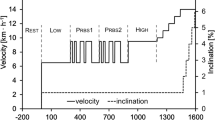Summary
The response of respiratory gas exchanges to a 6 week high intensity training program was examined in 5 healthy males during fixed term maximal incremental treadmill exercise. Training was performed 3 d·wk−1 and consisted of a progressive series of repeated 15 sec and 30 sec maximal runs, and weight training exercises for the leg extensor muscles. Respiratory gases during the tests were continuously monitored using an on-line system. Muscle biopsy samples were obtained from the m. vastus lateralis before and after training for histochemical determination of fibre distribution based on myosin ATP-ase activity, and fibre cross-sectional area based on NADH-Tetrazolium Reductase activity. Training significantly increased the proportion of type IIa fibres (+5.9±2.0%,p<0.001) and decreased type I fibres (−6.3±2.0%,p<0.001), the distribution of type IIb fibres remained unchanged (+0.4±0.9%). Muscle cross-sectional area also showed a significant increase after training in type I (+ 318±215 μm2,p<0.05), IIa (+652±207 μm2,p<0.001) and IIb (+773±196 μm2,p< 0.001) fibres. During fixed term maximal incremental exercise the mean carbon dioxide output (\(\dot V_{{\text{CO}}_{\text{2}} } \)) and mean respiratory exchange ratio (\(R = \dot V_{{\text{CO}}_{\text{2}} } /\dot V_{{\text{O}}_{\text{2}} } \)) were significantly increased (p<0.01) after training. The R-time relationship was at all times shifted to the left after training, being significantly (p<0.01) so over the final five min of exercise. No changes in mean exercise oxygen uptake (\(\dot V_{{\text{O}}_{\text{2}} } \)), maximum oxygen uptake (\(\dot V_{{\text{O}}_{{\text{2}} {\text{max}}} } \)) and maximum heart rate (FHRmax) were observed between tests. These results indicate that high intensity training can significantly affect respiratory exchange during fixed term progressive exercise.
Similar content being viewed by others
References
Aitken JC, Thompson J (1988) The respiratory\(\dot V_{{\text{CO}}_{\text{2}} } /\dot V_{{\text{O}}_{\text{2}} } \) exchange ratio during maximum exercise and its use as a predictor of maximum oxygen uptake. Eur J Appl Physiol 57:714–719
Brooke M, Kaiser K (1970) Three ‘myosin ATPase’ systems. The nature of their pH lability and sulphydryl dependence. J Histochem Cytochem 18:670–672
Costill DL, Coyle EF, Fink WF, Lesmes GR, Witzmann FA (1979) Adaptations in skeletal muscle following strength training. J Appl Physiol 46:96–99
Côté C, Simoneau JA, Lagassé P, Boulay M, Thibault MC, Marcotte M, Bouchard C (1988) Isokinetic strength training protocols: do they induce skeletal muscle fibre hypertrophy? Arch Physiol Med Rehabil 69:281–285
Dietrichson P, Coakley J, Smith PEM, Griffiths RD, Helliwell TR, Edwards RHT (1987) Conchotome and needle percutaneous biopsy of skeletal muscle. J Neurol Neurosurg Psychiat 50:1461–1467
Dubowitz V, Brooke MH (1973) Muscle biopsy: A modern approach. Saunders, London
Gutmann I and Wahlefeld AW (1974) In: Bergmeyer HU (ed) Methods of enzymatic analysis. Academic Press, New York, pp 1464–1468
Holloszy JO, Coyle EF (1984) Adaptations of skeletal muscle to endurance exercise and their metabolic consequences. J Appl Physiol 56:831–838
Jacobs I, Esbjörnsson M, Sylvén C, Holm I, Jansson E (1987) Sprint training effects on muscle myoglobin, enzymes, fibre types, and blood lactate. Med Sci Sports Exerc 19:368–374
Lojda Z, Gossrau R, Schiebler (1979) Enzyme histochemistry a laboratory manual. Springer, Berlin Heidelberg New York, pp 262–266
Osnes JB, Hermansen L (1972) Acid-base balance after maximal exercise of short duration. J Appl Physiol 32:59–63
Parkhouse WS, McKenzie DC (1984) Possible contribution of skeletal muscle buffers to enhanced anaerobic performance: a brief review. Med Sci Sports Exerc 16:328–338
Prince FP, Hikida RS, Hagerman FC (1976) Human muscle fibre types in power lifters, distance runners and untrained subjects. Pflügers Arch 363:19–26
Roberts AD, Billeter R, Howald H (1982) Anaerobic muscle enzyme changes after interval training. Int J Sports Med 3:18–21
Sahlin K (1978) Intracellular pH and energy metabolism in skeletal muscle of man. Acta Physiol Scand [Suppl 455] 1–56
Schantz P, Henriksson J, Jansson E (1983) Adaptations of human skeletal muscle to endurance training of long duration. Clin Physiol 3:141–151
Sharp RL, Costill DL, Fink WJ, King DS (1986) Effects of eight weeks of bicycle ergometer sprint training on human muscle buffer capacity. Int J Sports Med 7:13–17
Tesch PA, Komi PV, Hakkinen K (1987) Enzymatic adaptations consequent to long-term strength training. Int J Sports Med 8:66–69
Tesch PA, Thorsson A, Kaiser P (1984) Muscle capillary supply and fibre type characteristics in weight and power lifters. J Appl Physiol 56:35–38
Tesch PA, Wright JE, Vogel JA, Daniels WL, Sharp DS, Sjodin B (1985) The influence of muscle metabolic characteristics on physical performance. Eur J Appl Physiol 54:237–243
Thompson J (1984) Patient anthropmetric assessment and storage utilising a cheap micro-computer system. Br J Pharmacol 83:426P
Thorstensson A, Sjödin B, Karlsson J (1975) Enzyme activities and muscle strength after “sprint training” in man. Acta Physiol Scand 94:313–318
Watt PW, MacLennan PA, Hundal HS, Kuret CM, Rennie MJ (1988) L(+)lactate transport in perfused rat skeletal muscle: kinetic characteristics and sensitivity to pH and transport inhibitors. Biochim Biophys Acta 944:213–222
Author information
Authors and Affiliations
Rights and permissions
About this article
Cite this article
Aitken, J.C., Bennet, W.M. & Thompson, J. The effects of high intensity training upon respiratory gas exchanges during fixed term maximal incremental exercise in man. Europ. J. Appl. Physiol. 58, 717–721 (1989). https://doi.org/10.1007/BF00637382
Accepted:
Issue Date:
DOI: https://doi.org/10.1007/BF00637382




